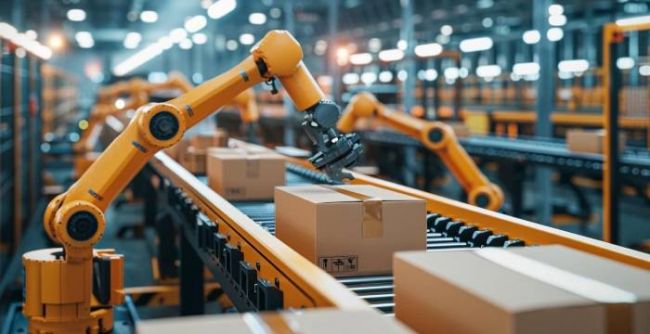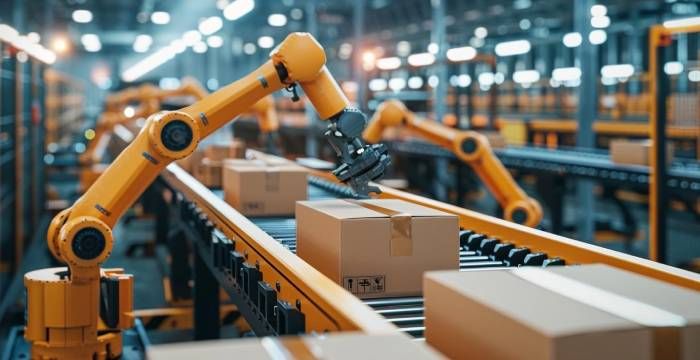Technology
6 min read
The Role of Modern Warehouses in Efficient Supply Chains


Do you know that feeling when your business is taking off? Your customers are getting their orders right on time, your workers are happy, and you have the right amount of products in stock.
What if we told you that could be your reality?
The times we are living in are full of changes. And these changes can feel scary and overwhelming.
But, we can use them to our advantage. We can use them to improve our business.

Companies like Amazon are already using modern solutions to improve their warehouse operations and they are seeing amazing results.
The size of the warehouse automation market is expected to grow to $42.25 billion in 2029 at an annual growth rate of 15.1%.
We’ll also talk about what’s influencing this change and mention some trends and companies that are changing the game (like Modula US vertical storage systems). Let’s get to it.
The supply chain is like a marathon. Your products move from the factory to your warehouse, and then to your customers. In order for your customers to have the best experience with your brand, all of these operations have to be as efficient as possible.
Modern warehouses help your business:
When everything is well-organized, fewer products will get lost or damaged, and your customers will get their orders on time.

So, we know that warehouses are becoming more and more modern, and that this is helping businesses improve their operations. But is there something else influencing this change?
With the rise of e-commerce, customers are expecting faster deliveries. They want speed, accuracy, and transparency.
The bar is rising, and warehouses have to process more orders, faster, which manual systems can't keep up with. So, they’re coming up with better solutions.
Automation tech (robots, sensors, AI, and IoT) is becoming more affordable and accessible. It’s no longer a privilege, but a necessity for businesses that want to stay ahead of the game.
Smart systems have shown to be very effective. They can track inventory in real time, predict demand, and reduce errors drastically.
The economy is not what it used to be and it’s becoming harder (and more expensive) to find and keep warehouse workers. Using robots is also safer for more physically demanding tasks.
Smart warehouses continuously collect data, enabling businesses to forecast demand, streamline stock levels, and optimize space. For instance, digital solutions like Classroom Screen highlight how technology can improve productivity in different environments, from education to logistics.
Creating a modern warehouse can help you transform your business. It can improve your operations and make sure your customers are always happy and keep coming back for more.
In a regular warehouse, employees have to spend a lot of time walking around, picking items from shelves, and packing them. This is repetitive and takes up a lot of their time. Automation changes that.
With automated picking systems, conveyor belts, and robotic arms, items can be located and moved with minimal human effort. So, instead of walking a mile each day inside a warehouse, your workers can just stand in one spot while the machines bring the products to them.
This results in faster fulfillment, shorter delivery times, and a big win in customer satisfaction.
Your customers expect the best. Inaccurate picking or shipping the wrong product can make them feel frustrated (even give up on your business).
Automated systems, guided by barcode scanners, RFID tags, and AI, won’t make mistakes. They verify products at each stage, so the right item gets sent to the right person. This helps create a more professional brand image.
Labor is one of the biggest expenses in any warehouse. Training, salaries, overtime… It can add up. And finding skilled workers is getting harder.
Automation handles the heavier and more repetitive tasks. This allows your team to focus on more important things and saves you time and money.
Unlike people, machines don’t get tired. With automation, your warehouse can run day and night. Even on weekends or holidays.
This is especially helpful if you serve customers in different time zones or want to make sure their orders arrive as soon as possible.
Ever been surprised by an out-of-stock item? That happens when inventory isn’t tracked in real time.
Automated systems track stock automatically as items are moved, picked, or replenished. This gives you a live view of your warehouse at any time.
That leads to better forecasting, fewer stockouts, and smarter reordering decisions. You only stock what you need, reduce waste, and never disappoint a customer with an “Oops, it’s out of stock.”
Customers don’t see your warehouse (obviously), but they feel its impact. Fast, accurate, and reliable service builds trust.
With automation, orders are fulfilled quickly and correctly. Inventory updates are instant. Even tracking info is more accurate thanks to integrated systems. And the best part is, you can track it from anywhere.

So, what are the biggest trends at the moment? Here are a few:
AMRs and AGVs help move your goods around the warehouse. They are very flexible, rerouting themselves in real time, and they help improve productivity and efficiency.
AI can help predict demand, shortages, and optimize inventory. Machine learning helps group products, predict shortages (also), and auto-replenish stock.
IoT is becoming more accessible, which is great news for warehouses. IoT sensors can monitor your inventory and the state of your equipment and help you know exactly where each device is.
RFID ensures accurate tracking and active RFID adoption improves traceability.
These systems integrate ERP/WMS with real-time automation. WES coordinates robots, conveyors, and workers dynamically, improving responsiveness.
With real-time analytics, WES can predict equipment failures or stock issues before they happen, helping your business always stay ahead and cut downtime.
Companies like Modula are creating vertical lift modules, which help you make the most of your storage space, while improving efficiency.
They bring goods directly to the operator at an optimal height. This reduces walking time, improves productivity and workspace safety.
We are living in a time of personalization and technological advancements. These changes are a lot to get used to, but the businesses that stay agile and adaptive will make it.
The trick is to find a solution that works for you and your business and give it your best shot. Do your research and see this time for the opportunities it brings us. We wish you the best of luck.
Be the first to post comment!